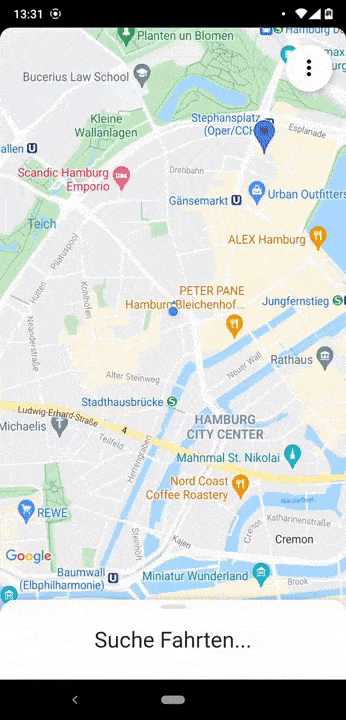Cyclopath, an application for riders of a food delivery startup, was originally a web app plagued by performance issues, leading to inefficiencies in delivery operations. Recognizing the need for an overhaul, I embarked on redesigning Cyclopath to offer a better user experience and faster handling, focusing on minimal user input and seamless integration of essential functions.
Overview
Key Features of Cyclopath Redesign

Simple Shift Selection
The redesign simplifies the shift start process with a straightforward time slot overview, enabling riders to easily select their working hours.

Automated Route Display and Order Management
Upon receiving orders, the route is automatically displayed. Riders can mark an order as delivered with a simple drag of a button, immediately showing the route for the next delivery.

Automated Return Route to Hub
Once all deliveries are completed, the app automatically displays the route back to the hub, streamlining the end-of-shift process for riders.
Opportunity
The existing web app was slow, often required restarts, and had a cumbersome process for accessing directions, usually necessitating manual input into Google Maps. The goal was to create an app tailored for riders, streamlining everything from login to order delivery and return to the hub, all with minimal user input.

Research and Analysis
Competitive Analysis
A thorough analysis of existing courier apps was conducted to identify common shortcomings and best practices in UI/UX design for delivery services.
User Surveys and Interviews
Surveys and one-on-one interviews with current riders provided insights into their challenges and needs, shaping the development of the new app.
Design Process
Ideation and Sketching
Rapid sketching sessions helped ideate on the user interface, focusing on simplicity and ease of navigation.
Wireframes and Prototyping
Low-fidelity wireframes were created to outline basic app functionality. These evolved into clickable prototypes for user testing.

High-Fidelity Prototype
Developing a high-fidelity prototype involved refining visuals and interactions, ensuring alignment with the overall design goals.
Usability Testing
Testers interacted with the prototype, providing feedback on usability and intuitiveness. The findings were crucial for the final design iteration.
Key Features and Improvements
- Integrated Google Maps: Direct integration for route planning and navigation, eliminating manual address input.
- Streamlined Order Management: Simplified interface for receiving and managing orders, with minimal user input.
- Efficient Route Optimization: Automated route optimization for deliveries, ensuring the fastest possible delivery times.
- User-Centric Design: A clean, intuitive interface focusing on the courier's ease of use during their entire shift.
- Reliable Performance: Enhanced app stability and speed, reducing the need for restarts and improving overall efficiency.
- Feedback Mechanism: Easy-to-use feedback options for continual improvement based on courier experiences.
Lessons Learned
- User-Centric Design is Key: Focusing on the end-user's needs and challenges is crucial in developing a functional and successful app.
- Simplicity Enhances Efficiency: Minimizing user input can significantly improve operational efficiency in a fast-paced environment.
- Continuous Feedback is Vital: Regular user feedback helps in refining the app and addressing issues promptly.
Conclusion
The Cyclopath app redesign successfully addresses the inefficiencies of the previous system, providing a streamlined, user-friendly, and efficient tool for riders. This project not only improves the daily operations of the food delivery startup but also highlights the importance of user-centered design in application development.
